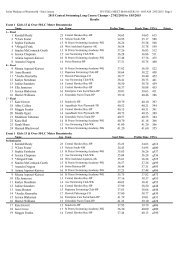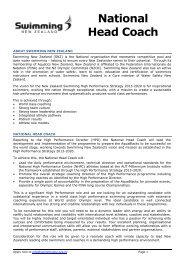LTAD Borders Swimming Community - Final
LTAD Borders Swimming Community - Final
LTAD Borders Swimming Community - Final
You also want an ePaper? Increase the reach of your titles
YUMPU automatically turns print PDFs into web optimized ePapers that Google loves.
TRAINING FREQUENCIES & VOLUMESThe table below displays training frequencies and durations for the four group levels that a number of <strong>Borders</strong> clubsimplemented with the advent of the <strong>Borders</strong> Performance Development Programme in June 2008. These levels andrecommendations are aligned to the British <strong>Swimming</strong> Long Term Athlete Development model.It is quite obvious to coaches when a swimmer must be moved down a level due to their stage of development &/or standard of performance. However, the decision to move a swimmer up a level should not be taken lightly and theserious consideration of a number of factors is required.Clubs with swimmers training more frequently andcompleting higher volumes, within recommendedranges, will almost always produce morecompetitive swimmers over the long term. Thisseems obvious but there are still many swimmerswith competitive aspirations who do not completeenough training. There simply is no substitute forhard work and commitment.LEVEL ONEMeeting recommended training frequencies, and thedevelopment of technique and skills in a fun environment,takes precedence over workload in this group level.The <strong>LTAD</strong> model recommends that children in Level Oneparticipate in general sport activities five to six timesper week. This should include land work and multisportactivity. Put simply, participation in a wide range ofsporting activities is recommended in order for children todevelop a wide range of skills and abilities for the future.From the suggested five to six “general sport” sessionsit is recommended that <strong>Borders</strong> swimmers completethree of those sessions in the pool. One of the reasonsfor recommending a higher proportion of swimming overother sports is that a greater proportion of time isrequired (in the water) to comprehensively develop swimspecific skills compared to that required for developingland-based skills.LEVEL TWOCoaches should prescribe the correct volumes and activitiesfor their swimmers according to their chronological &/orbiological age – if the swimmer is also capable of becomingmore competitive on this amount work this is a bonus.Parents and swimmers must focus on the process ratherthan the result. However, few children will continue withtheir sport if they are not experiencing some competitivesuccess at all stages. Pre-pubertal swimmers race withspeed through well-developed aerobic/endurance systems.Therefore adequate training volumes are essential for thisgroup level.Level 2 swimmers should be aiming at 8,000m -16,000m/week. Therefore if a Level 2 swimmer isattending the recommended 4 sessions per week theyshould be completing a minimum of 2,000m per session.Swimmers will need sessions of up to 1.5 hours tocomplete these volumes. This should be occurring over44 to 48 weeks of the year.




